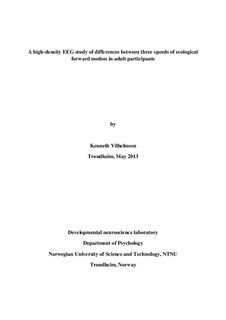| dc.contributor.advisor | Van der Meer, Audrey | nb_NO |
| dc.contributor.advisor | Van der Weel, Ruud | nb_NO |
| dc.contributor.author | Vilhelmsen, Kenneth | nb_NO |
| dc.date.accessioned | 2014-12-19T14:43:01Z | |
| dc.date.available | 2014-12-19T14:43:01Z | |
| dc.date.created | 2013-10-25 | nb_NO |
| dc.date.issued | 2013 | nb_NO |
| dc.identifier | 659535 | nb_NO |
| dc.identifier.uri | http://hdl.handle.net/11250/271104 | |
| dc.description.abstract | A high-density EEG study was conducted to investigate evoked and oscillatory activity in response to three different stimulus speeds of simulated forward motion in adult participants. Participants were shown an optic flow stimulus consisting of a virtual road with moving poles at either side of it simulating forward motion at three different speeds (low, medium, and high) with a static control condition between each motion condition. The aim was to analyse the N2 component of visual motion and the evoked oscillatory activity in occipital and parietal areas.
A significant difference in N2 latencies and peak amplitudes between the three stimulus speeds were found in parietal channels P3 and P4. The peak latency significantly increased as the simulated speeds increased, while the peak amplitudes decreased at increasing speeds. The latency differences were thought to indicate that the low simulated speed was easier to process than the faster medium and high simulated speeds, while the change in peak amplitude seemed to be the result of a greater number of neurons being attuned to the lower as opposed to the higher stimulus speeds.
Theta-band synchronizations and alpha-band de-synchronizations in the three different speeds were observed, but no significant differences between the speeds were found. The static condition, in contrast, showed theta-band de-synchronizations and alpha-band synchronizations. Significant differences between the alpha de-synchronizations in the three different speeds and the alpha synchronizations in the static condition were found in the parietal midline source, while no significant differences were found between conditions in the theta oscillations. It was suggested that the alpha de-synchronizations reflect an activated state, possibly related to the visual processing of the three speeds, whereas the alpha synchronizations in response to the static condition reflect a deactivated resting period. | nb_NO |
| dc.language | eng | nb_NO |
| dc.publisher | Norges teknisk-naturvitenskapelige universitet, Fakultet for samfunnsvitenskap og teknologiledelse, Psykologisk institutt | nb_NO |
| dc.title | A high-density EEG study of differences between three speeds of ecological forward motion in adult participants | nb_NO |
| dc.type | Master thesis | nb_NO |
| dc.source.pagenumber | 49 | nb_NO |
| dc.contributor.department | Norges teknisk-naturvitenskapelige universitet, Fakultet for samfunnsvitenskap og teknologiledelse, Psykologisk institutt | nb_NO |
